Global Maternal Health
VerifiedAdded on 2023/02/01
|14
|3370
|47
AI Summary
This article discusses the social determinants of global maternal health and provides recommended strategies to improve maternal care. It explores the impact of socio-economic background, maternal education, gender inequality, social infrastructure, breakdown of marriage, and sexual assault on maternal health. The article also emphasizes the importance of cultural safety in delivering effective maternal care.
Contribute Materials
Your contribution can guide someone’s learning journey. Share your
documents today.
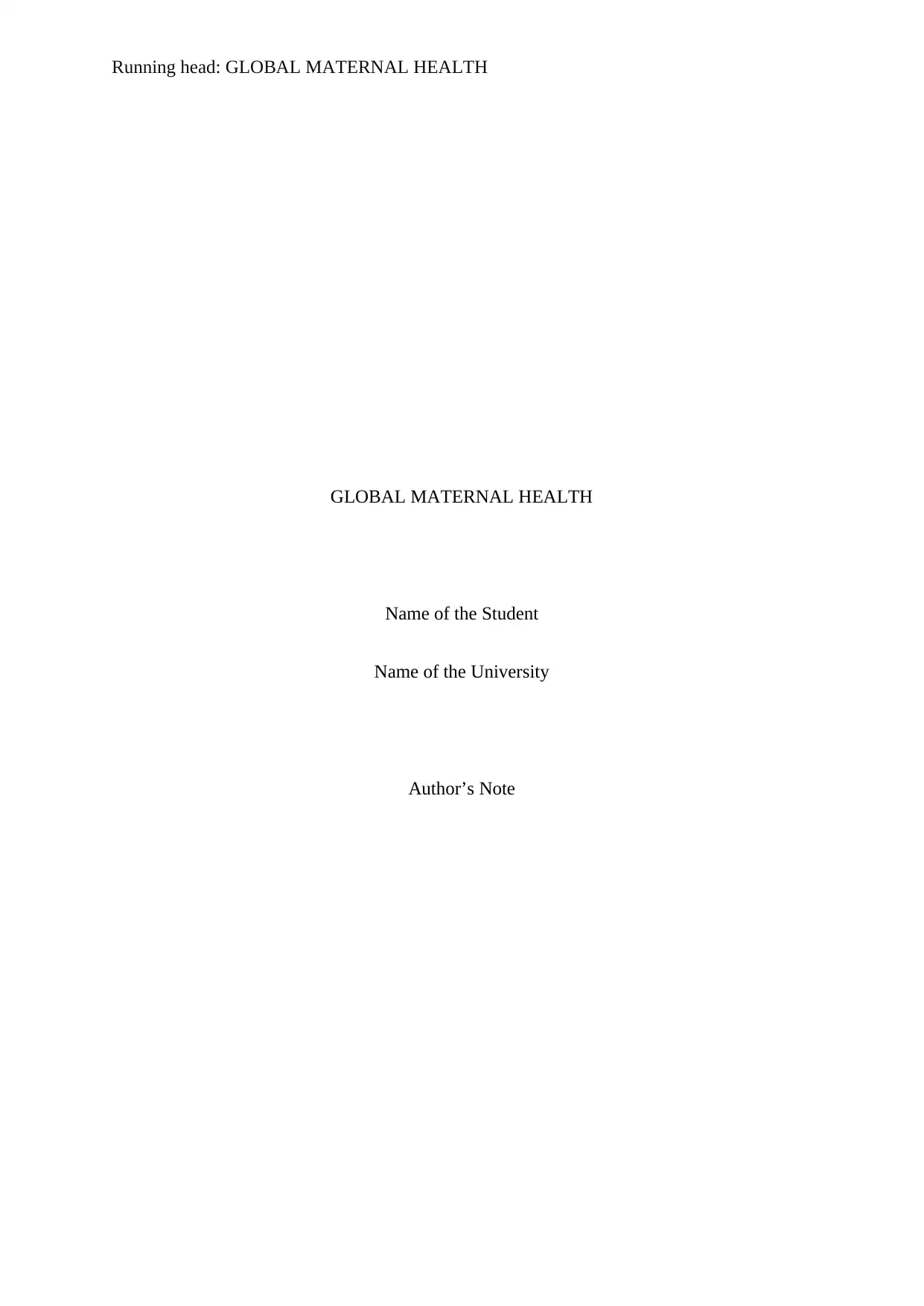
Running head: GLOBAL MATERNAL HEALTH
GLOBAL MATERNAL HEALTH
Name of the Student
Name of the University
Author’s Note
GLOBAL MATERNAL HEALTH
Name of the Student
Name of the University
Author’s Note
Secure Best Marks with AI Grader
Need help grading? Try our AI Grader for instant feedback on your assignments.
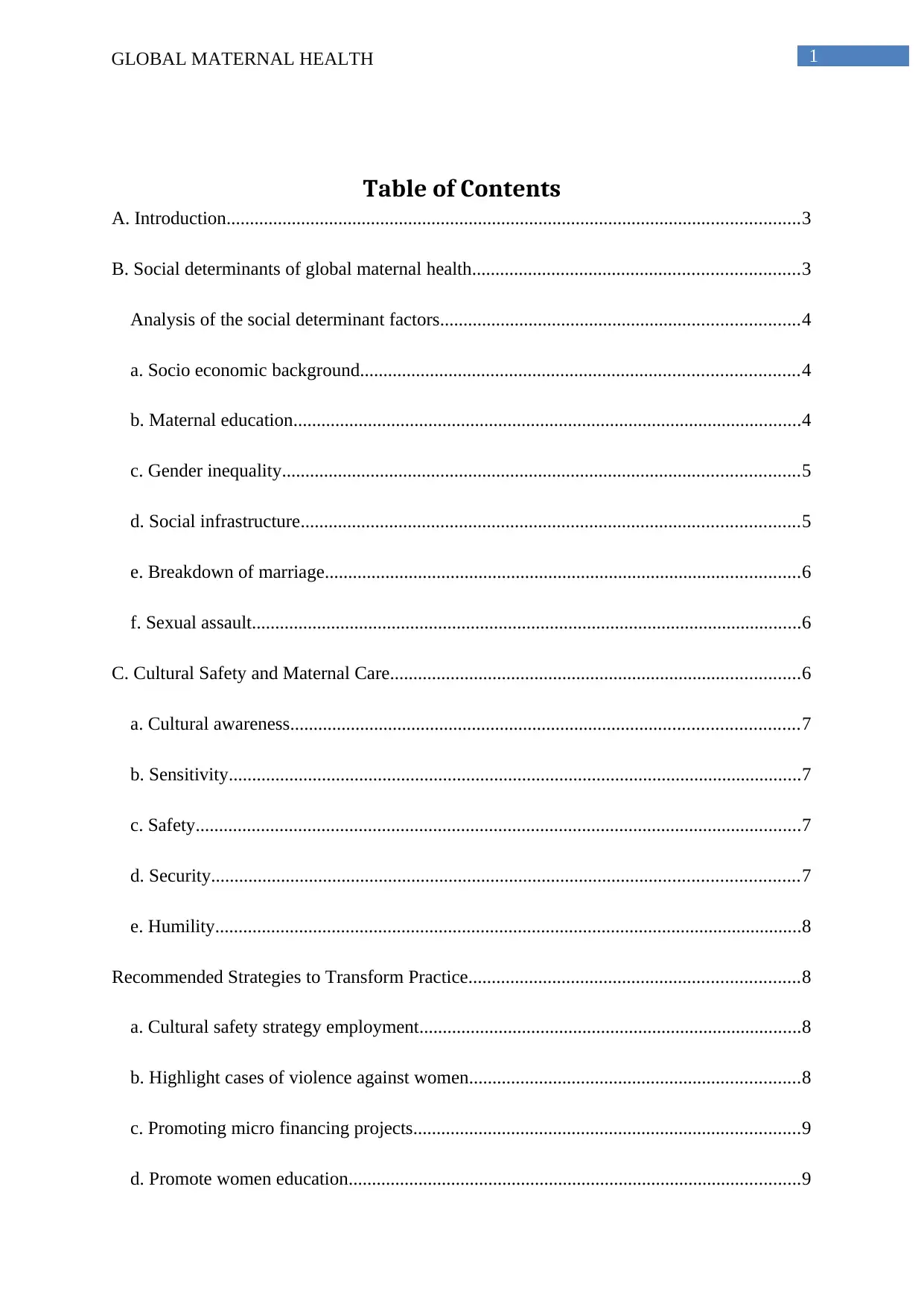
1GLOBAL MATERNAL HEALTH
Table of Contents
A. Introduction...........................................................................................................................3
B. Social determinants of global maternal health......................................................................3
Analysis of the social determinant factors.............................................................................4
a. Socio economic background..............................................................................................4
b. Maternal education.............................................................................................................4
c. Gender inequality...............................................................................................................5
d. Social infrastructure...........................................................................................................5
e. Breakdown of marriage......................................................................................................6
f. Sexual assault......................................................................................................................6
C. Cultural Safety and Maternal Care........................................................................................6
a. Cultural awareness.............................................................................................................7
b. Sensitivity...........................................................................................................................7
c. Safety..................................................................................................................................7
d. Security..............................................................................................................................7
e. Humility..............................................................................................................................8
Recommended Strategies to Transform Practice.......................................................................8
a. Cultural safety strategy employment..................................................................................8
b. Highlight cases of violence against women.......................................................................8
c. Promoting micro financing projects...................................................................................9
d. Promote women education.................................................................................................9
Table of Contents
A. Introduction...........................................................................................................................3
B. Social determinants of global maternal health......................................................................3
Analysis of the social determinant factors.............................................................................4
a. Socio economic background..............................................................................................4
b. Maternal education.............................................................................................................4
c. Gender inequality...............................................................................................................5
d. Social infrastructure...........................................................................................................5
e. Breakdown of marriage......................................................................................................6
f. Sexual assault......................................................................................................................6
C. Cultural Safety and Maternal Care........................................................................................6
a. Cultural awareness.............................................................................................................7
b. Sensitivity...........................................................................................................................7
c. Safety..................................................................................................................................7
d. Security..............................................................................................................................7
e. Humility..............................................................................................................................8
Recommended Strategies to Transform Practice.......................................................................8
a. Cultural safety strategy employment..................................................................................8
b. Highlight cases of violence against women.......................................................................8
c. Promoting micro financing projects...................................................................................9
d. Promote women education.................................................................................................9
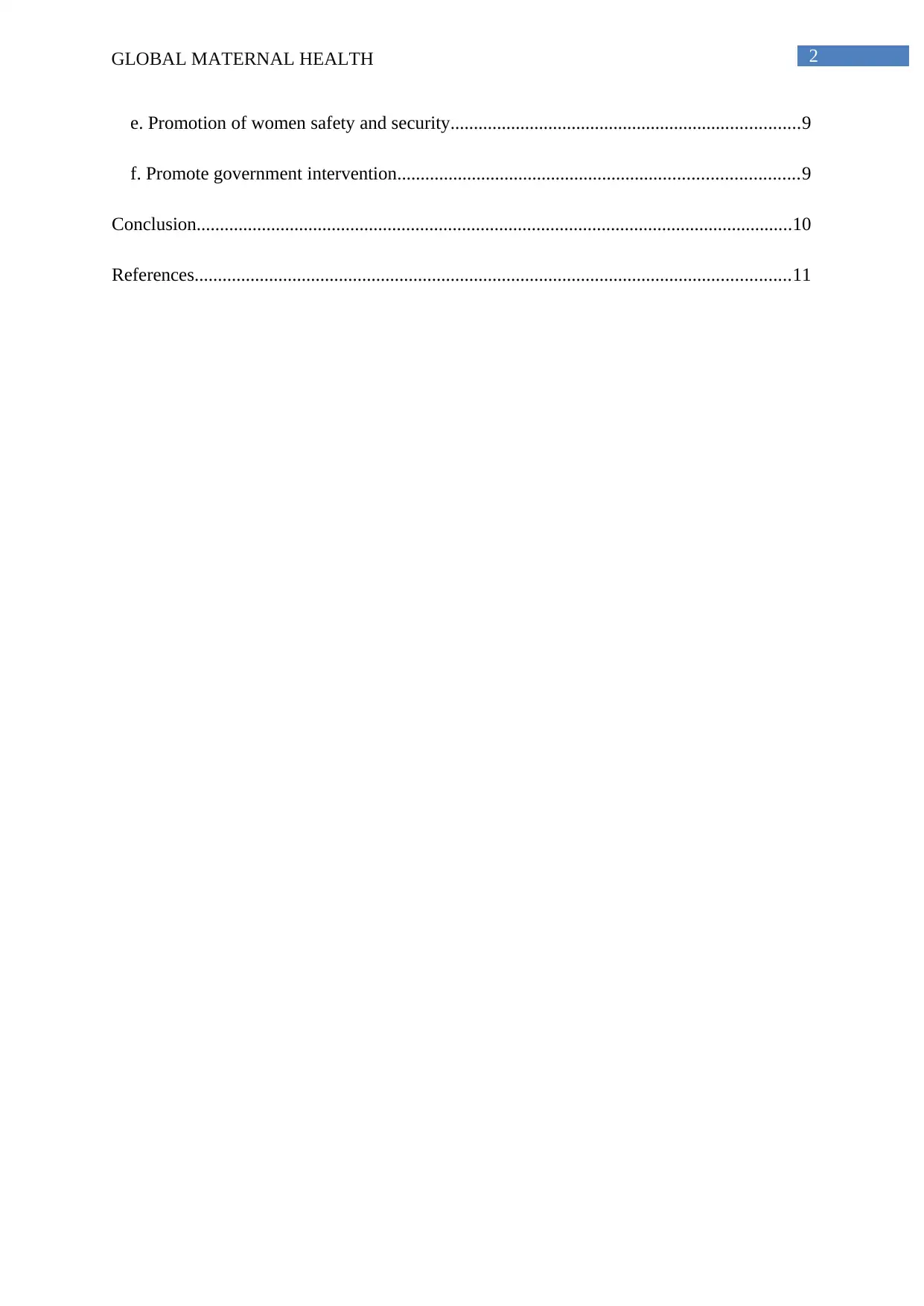
2GLOBAL MATERNAL HEALTH
e. Promotion of women safety and security...........................................................................9
f. Promote government intervention......................................................................................9
Conclusion................................................................................................................................10
References................................................................................................................................11
e. Promotion of women safety and security...........................................................................9
f. Promote government intervention......................................................................................9
Conclusion................................................................................................................................10
References................................................................................................................................11
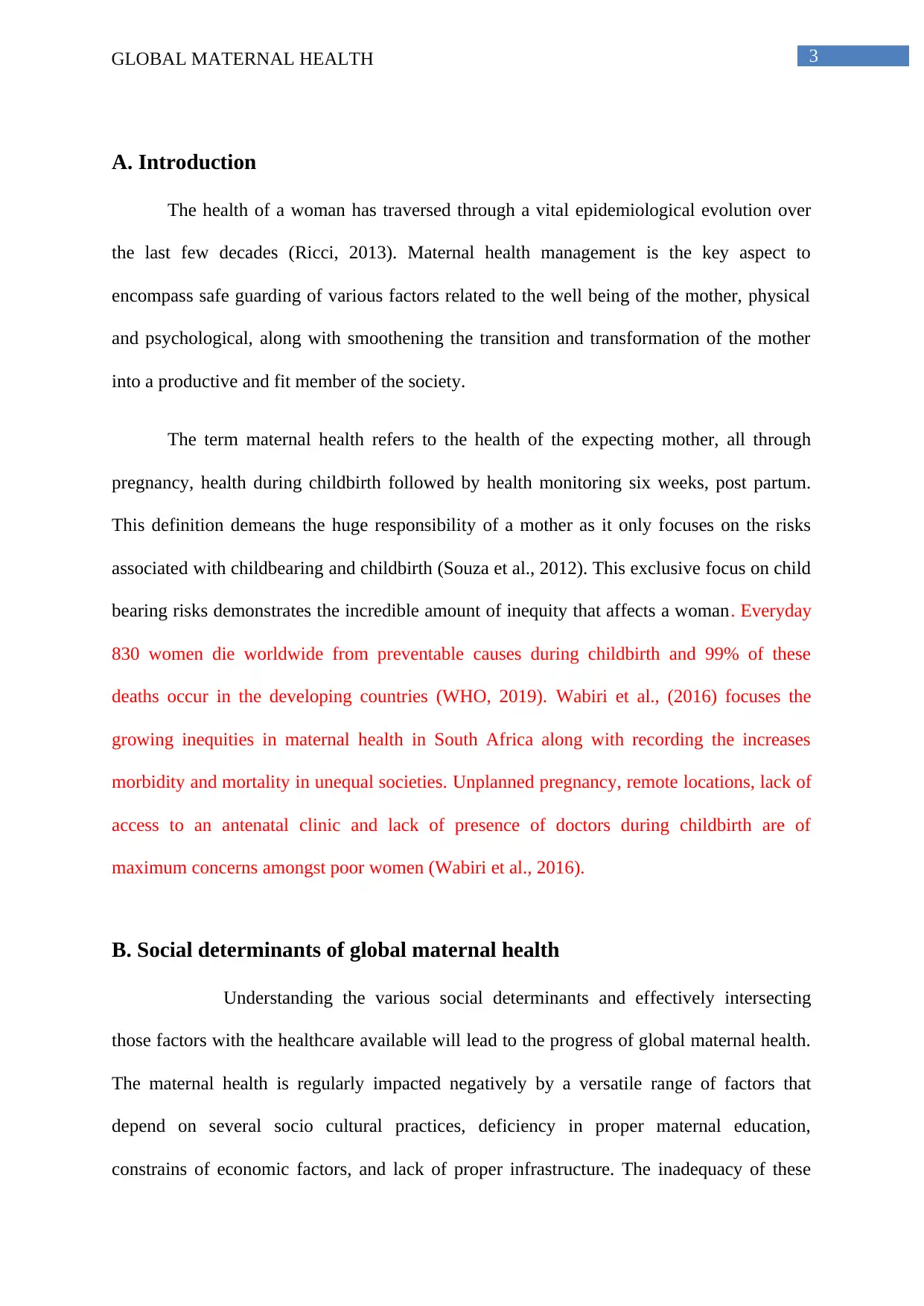
3GLOBAL MATERNAL HEALTH
A. Introduction
The health of a woman has traversed through a vital epidemiological evolution over
the last few decades (Ricci, 2013). Maternal health management is the key aspect to
encompass safe guarding of various factors related to the well being of the mother, physical
and psychological, along with smoothening the transition and transformation of the mother
into a productive and fit member of the society.
The term maternal health refers to the health of the expecting mother, all through
pregnancy, health during childbirth followed by health monitoring six weeks, post partum.
This definition demeans the huge responsibility of a mother as it only focuses on the risks
associated with childbearing and childbirth (Souza et al., 2012). This exclusive focus on child
bearing risks demonstrates the incredible amount of inequity that affects a woman. Everyday
830 women die worldwide from preventable causes during childbirth and 99% of these
deaths occur in the developing countries (WHO, 2019). Wabiri et al., (2016) focuses the
growing inequities in maternal health in South Africa along with recording the increases
morbidity and mortality in unequal societies. Unplanned pregnancy, remote locations, lack of
access to an antenatal clinic and lack of presence of doctors during childbirth are of
maximum concerns amongst poor women (Wabiri et al., 2016).
B. Social determinants of global maternal health
Understanding the various social determinants and effectively intersecting
those factors with the healthcare available will lead to the progress of global maternal health.
The maternal health is regularly impacted negatively by a versatile range of factors that
depend on several socio cultural practices, deficiency in proper maternal education,
constrains of economic factors, and lack of proper infrastructure. The inadequacy of these
A. Introduction
The health of a woman has traversed through a vital epidemiological evolution over
the last few decades (Ricci, 2013). Maternal health management is the key aspect to
encompass safe guarding of various factors related to the well being of the mother, physical
and psychological, along with smoothening the transition and transformation of the mother
into a productive and fit member of the society.
The term maternal health refers to the health of the expecting mother, all through
pregnancy, health during childbirth followed by health monitoring six weeks, post partum.
This definition demeans the huge responsibility of a mother as it only focuses on the risks
associated with childbearing and childbirth (Souza et al., 2012). This exclusive focus on child
bearing risks demonstrates the incredible amount of inequity that affects a woman. Everyday
830 women die worldwide from preventable causes during childbirth and 99% of these
deaths occur in the developing countries (WHO, 2019). Wabiri et al., (2016) focuses the
growing inequities in maternal health in South Africa along with recording the increases
morbidity and mortality in unequal societies. Unplanned pregnancy, remote locations, lack of
access to an antenatal clinic and lack of presence of doctors during childbirth are of
maximum concerns amongst poor women (Wabiri et al., 2016).
B. Social determinants of global maternal health
Understanding the various social determinants and effectively intersecting
those factors with the healthcare available will lead to the progress of global maternal health.
The maternal health is regularly impacted negatively by a versatile range of factors that
depend on several socio cultural practices, deficiency in proper maternal education,
constrains of economic factors, and lack of proper infrastructure. The inadequacy of these
Secure Best Marks with AI Grader
Need help grading? Try our AI Grader for instant feedback on your assignments.
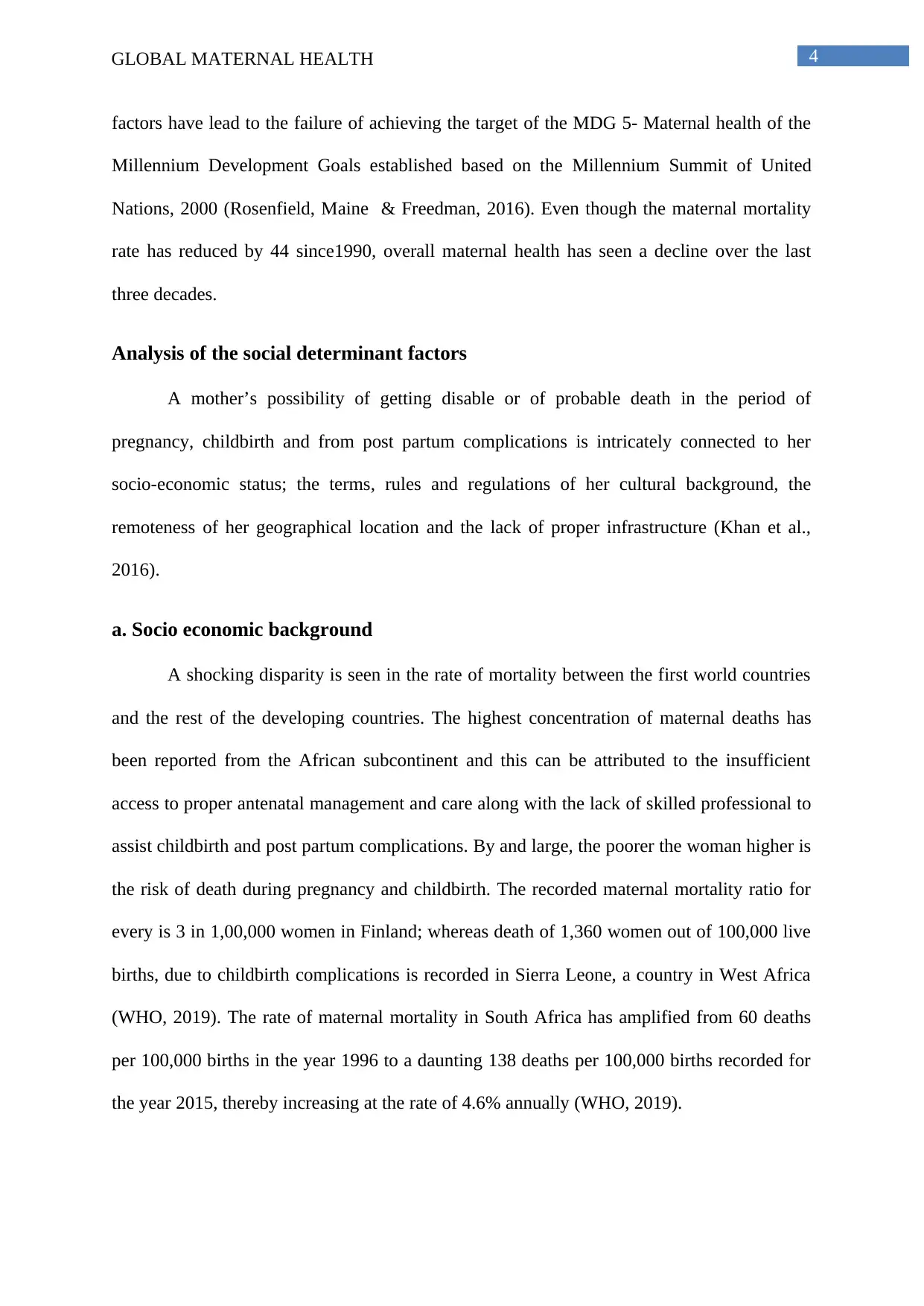
4GLOBAL MATERNAL HEALTH
factors have lead to the failure of achieving the target of the MDG 5- Maternal health of the
Millennium Development Goals established based on the Millennium Summit of United
Nations, 2000 (Rosenfield, Maine & Freedman, 2016). Even though the maternal mortality
rate has reduced by 44 since1990, overall maternal health has seen a decline over the last
three decades.
Analysis of the social determinant factors
A mother’s possibility of getting disable or of probable death in the period of
pregnancy, childbirth and from post partum complications is intricately connected to her
socio-economic status; the terms, rules and regulations of her cultural background, the
remoteness of her geographical location and the lack of proper infrastructure (Khan et al.,
2016).
a. Socio economic background
A shocking disparity is seen in the rate of mortality between the first world countries
and the rest of the developing countries. The highest concentration of maternal deaths has
been reported from the African subcontinent and this can be attributed to the insufficient
access to proper antenatal management and care along with the lack of skilled professional to
assist childbirth and post partum complications. By and large, the poorer the woman higher is
the risk of death during pregnancy and childbirth. The recorded maternal mortality ratio for
every is 3 in 1,00,000 women in Finland; whereas death of 1,360 women out of 100,000 live
births, due to childbirth complications is recorded in Sierra Leone, a country in West Africa
(WHO, 2019). The rate of maternal mortality in South Africa has amplified from 60 deaths
per 100,000 births in the year 1996 to a daunting 138 deaths per 100,000 births recorded for
the year 2015, thereby increasing at the rate of 4.6% annually (WHO, 2019).
factors have lead to the failure of achieving the target of the MDG 5- Maternal health of the
Millennium Development Goals established based on the Millennium Summit of United
Nations, 2000 (Rosenfield, Maine & Freedman, 2016). Even though the maternal mortality
rate has reduced by 44 since1990, overall maternal health has seen a decline over the last
three decades.
Analysis of the social determinant factors
A mother’s possibility of getting disable or of probable death in the period of
pregnancy, childbirth and from post partum complications is intricately connected to her
socio-economic status; the terms, rules and regulations of her cultural background, the
remoteness of her geographical location and the lack of proper infrastructure (Khan et al.,
2016).
a. Socio economic background
A shocking disparity is seen in the rate of mortality between the first world countries
and the rest of the developing countries. The highest concentration of maternal deaths has
been reported from the African subcontinent and this can be attributed to the insufficient
access to proper antenatal management and care along with the lack of skilled professional to
assist childbirth and post partum complications. By and large, the poorer the woman higher is
the risk of death during pregnancy and childbirth. The recorded maternal mortality ratio for
every is 3 in 1,00,000 women in Finland; whereas death of 1,360 women out of 100,000 live
births, due to childbirth complications is recorded in Sierra Leone, a country in West Africa
(WHO, 2019). The rate of maternal mortality in South Africa has amplified from 60 deaths
per 100,000 births in the year 1996 to a daunting 138 deaths per 100,000 births recorded for
the year 2015, thereby increasing at the rate of 4.6% annually (WHO, 2019).
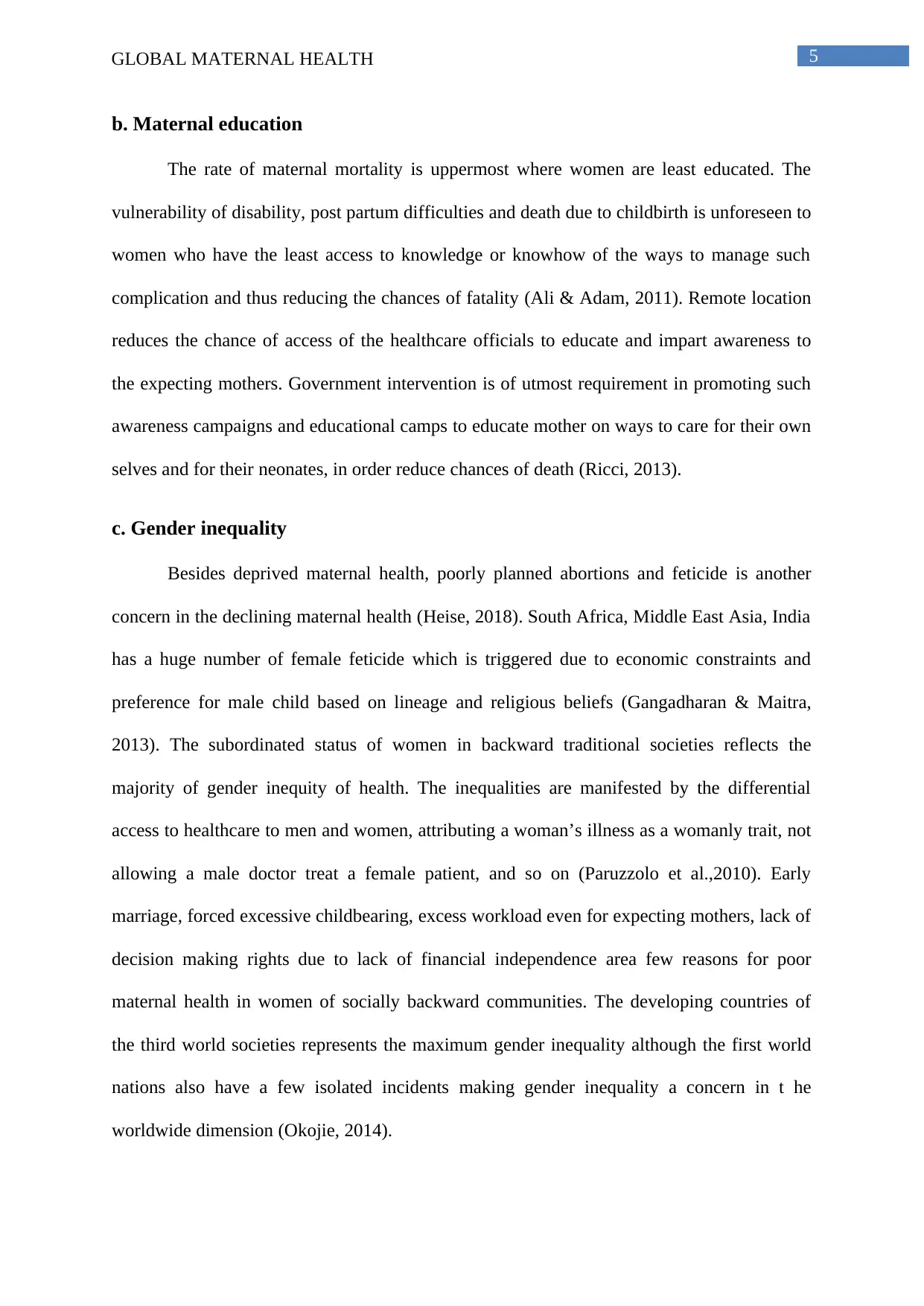
5GLOBAL MATERNAL HEALTH
b. Maternal education
The rate of maternal mortality is uppermost where women are least educated. The
vulnerability of disability, post partum difficulties and death due to childbirth is unforeseen to
women who have the least access to knowledge or knowhow of the ways to manage such
complication and thus reducing the chances of fatality (Ali & Adam, 2011). Remote location
reduces the chance of access of the healthcare officials to educate and impart awareness to
the expecting mothers. Government intervention is of utmost requirement in promoting such
awareness campaigns and educational camps to educate mother on ways to care for their own
selves and for their neonates, in order reduce chances of death (Ricci, 2013).
c. Gender inequality
Besides deprived maternal health, poorly planned abortions and feticide is another
concern in the declining maternal health (Heise, 2018). South Africa, Middle East Asia, India
has a huge number of female feticide which is triggered due to economic constraints and
preference for male child based on lineage and religious beliefs (Gangadharan & Maitra,
2013). The subordinated status of women in backward traditional societies reflects the
majority of gender inequity of health. The inequalities are manifested by the differential
access to healthcare to men and women, attributing a woman’s illness as a womanly trait, not
allowing a male doctor treat a female patient, and so on (Paruzzolo et al.,2010). Early
marriage, forced excessive childbearing, excess workload even for expecting mothers, lack of
decision making rights due to lack of financial independence area few reasons for poor
maternal health in women of socially backward communities. The developing countries of
the third world societies represents the maximum gender inequality although the first world
nations also have a few isolated incidents making gender inequality a concern in t he
worldwide dimension (Okojie, 2014).
b. Maternal education
The rate of maternal mortality is uppermost where women are least educated. The
vulnerability of disability, post partum difficulties and death due to childbirth is unforeseen to
women who have the least access to knowledge or knowhow of the ways to manage such
complication and thus reducing the chances of fatality (Ali & Adam, 2011). Remote location
reduces the chance of access of the healthcare officials to educate and impart awareness to
the expecting mothers. Government intervention is of utmost requirement in promoting such
awareness campaigns and educational camps to educate mother on ways to care for their own
selves and for their neonates, in order reduce chances of death (Ricci, 2013).
c. Gender inequality
Besides deprived maternal health, poorly planned abortions and feticide is another
concern in the declining maternal health (Heise, 2018). South Africa, Middle East Asia, India
has a huge number of female feticide which is triggered due to economic constraints and
preference for male child based on lineage and religious beliefs (Gangadharan & Maitra,
2013). The subordinated status of women in backward traditional societies reflects the
majority of gender inequity of health. The inequalities are manifested by the differential
access to healthcare to men and women, attributing a woman’s illness as a womanly trait, not
allowing a male doctor treat a female patient, and so on (Paruzzolo et al.,2010). Early
marriage, forced excessive childbearing, excess workload even for expecting mothers, lack of
decision making rights due to lack of financial independence area few reasons for poor
maternal health in women of socially backward communities. The developing countries of
the third world societies represents the maximum gender inequality although the first world
nations also have a few isolated incidents making gender inequality a concern in t he
worldwide dimension (Okojie, 2014).
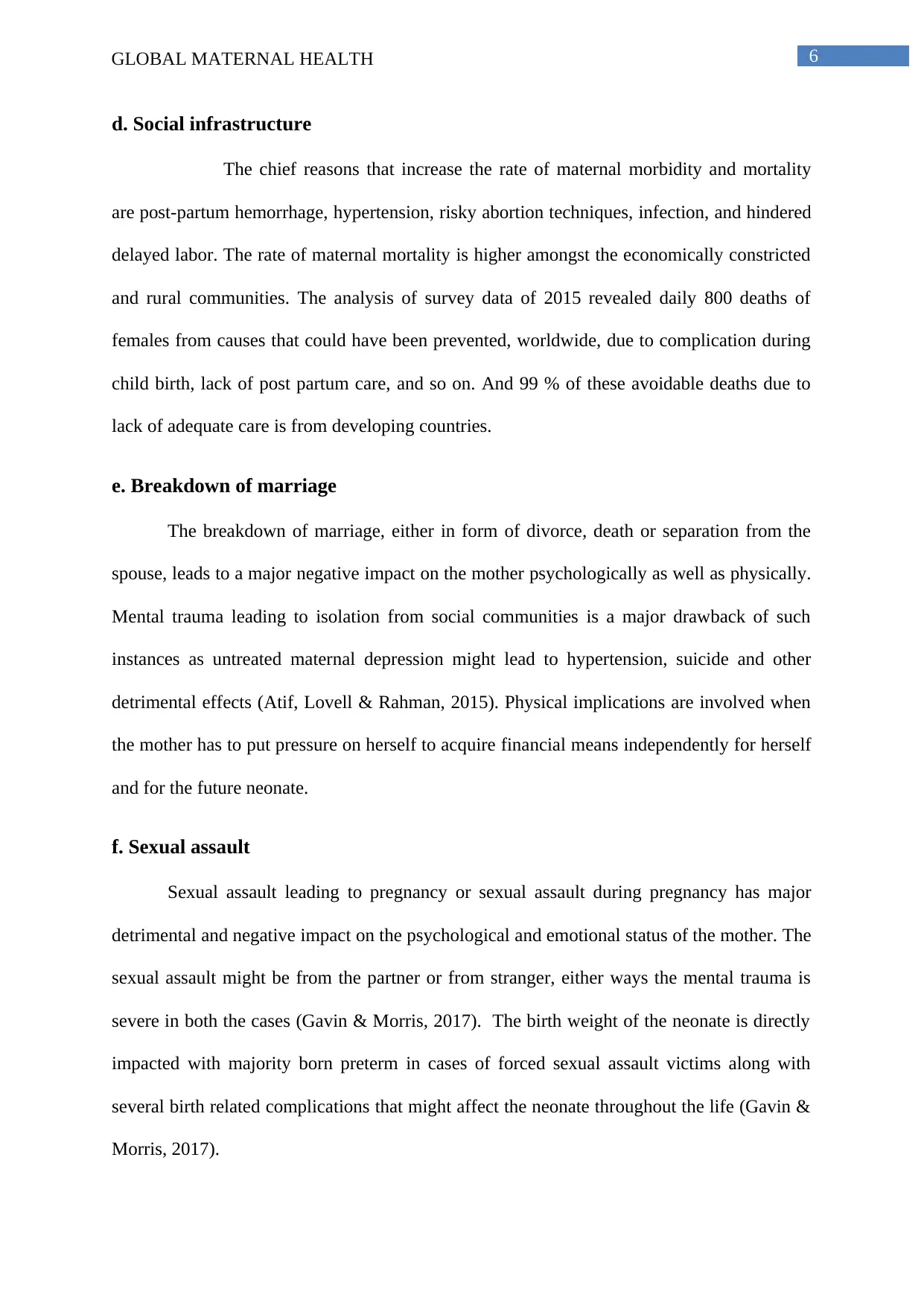
6GLOBAL MATERNAL HEALTH
d. Social infrastructure
The chief reasons that increase the rate of maternal morbidity and mortality
are post-partum hemorrhage, hypertension, risky abortion techniques, infection, and hindered
delayed labor. The rate of maternal mortality is higher amongst the economically constricted
and rural communities. The analysis of survey data of 2015 revealed daily 800 deaths of
females from causes that could have been prevented, worldwide, due to complication during
child birth, lack of post partum care, and so on. And 99 % of these avoidable deaths due to
lack of adequate care is from developing countries.
e. Breakdown of marriage
The breakdown of marriage, either in form of divorce, death or separation from the
spouse, leads to a major negative impact on the mother psychologically as well as physically.
Mental trauma leading to isolation from social communities is a major drawback of such
instances as untreated maternal depression might lead to hypertension, suicide and other
detrimental effects (Atif, Lovell & Rahman, 2015). Physical implications are involved when
the mother has to put pressure on herself to acquire financial means independently for herself
and for the future neonate.
f. Sexual assault
Sexual assault leading to pregnancy or sexual assault during pregnancy has major
detrimental and negative impact on the psychological and emotional status of the mother. The
sexual assault might be from the partner or from stranger, either ways the mental trauma is
severe in both the cases (Gavin & Morris, 2017). The birth weight of the neonate is directly
impacted with majority born preterm in cases of forced sexual assault victims along with
several birth related complications that might affect the neonate throughout the life (Gavin &
Morris, 2017).
d. Social infrastructure
The chief reasons that increase the rate of maternal morbidity and mortality
are post-partum hemorrhage, hypertension, risky abortion techniques, infection, and hindered
delayed labor. The rate of maternal mortality is higher amongst the economically constricted
and rural communities. The analysis of survey data of 2015 revealed daily 800 deaths of
females from causes that could have been prevented, worldwide, due to complication during
child birth, lack of post partum care, and so on. And 99 % of these avoidable deaths due to
lack of adequate care is from developing countries.
e. Breakdown of marriage
The breakdown of marriage, either in form of divorce, death or separation from the
spouse, leads to a major negative impact on the mother psychologically as well as physically.
Mental trauma leading to isolation from social communities is a major drawback of such
instances as untreated maternal depression might lead to hypertension, suicide and other
detrimental effects (Atif, Lovell & Rahman, 2015). Physical implications are involved when
the mother has to put pressure on herself to acquire financial means independently for herself
and for the future neonate.
f. Sexual assault
Sexual assault leading to pregnancy or sexual assault during pregnancy has major
detrimental and negative impact on the psychological and emotional status of the mother. The
sexual assault might be from the partner or from stranger, either ways the mental trauma is
severe in both the cases (Gavin & Morris, 2017). The birth weight of the neonate is directly
impacted with majority born preterm in cases of forced sexual assault victims along with
several birth related complications that might affect the neonate throughout the life (Gavin &
Morris, 2017).
Paraphrase This Document
Need a fresh take? Get an instant paraphrase of this document with our AI Paraphraser
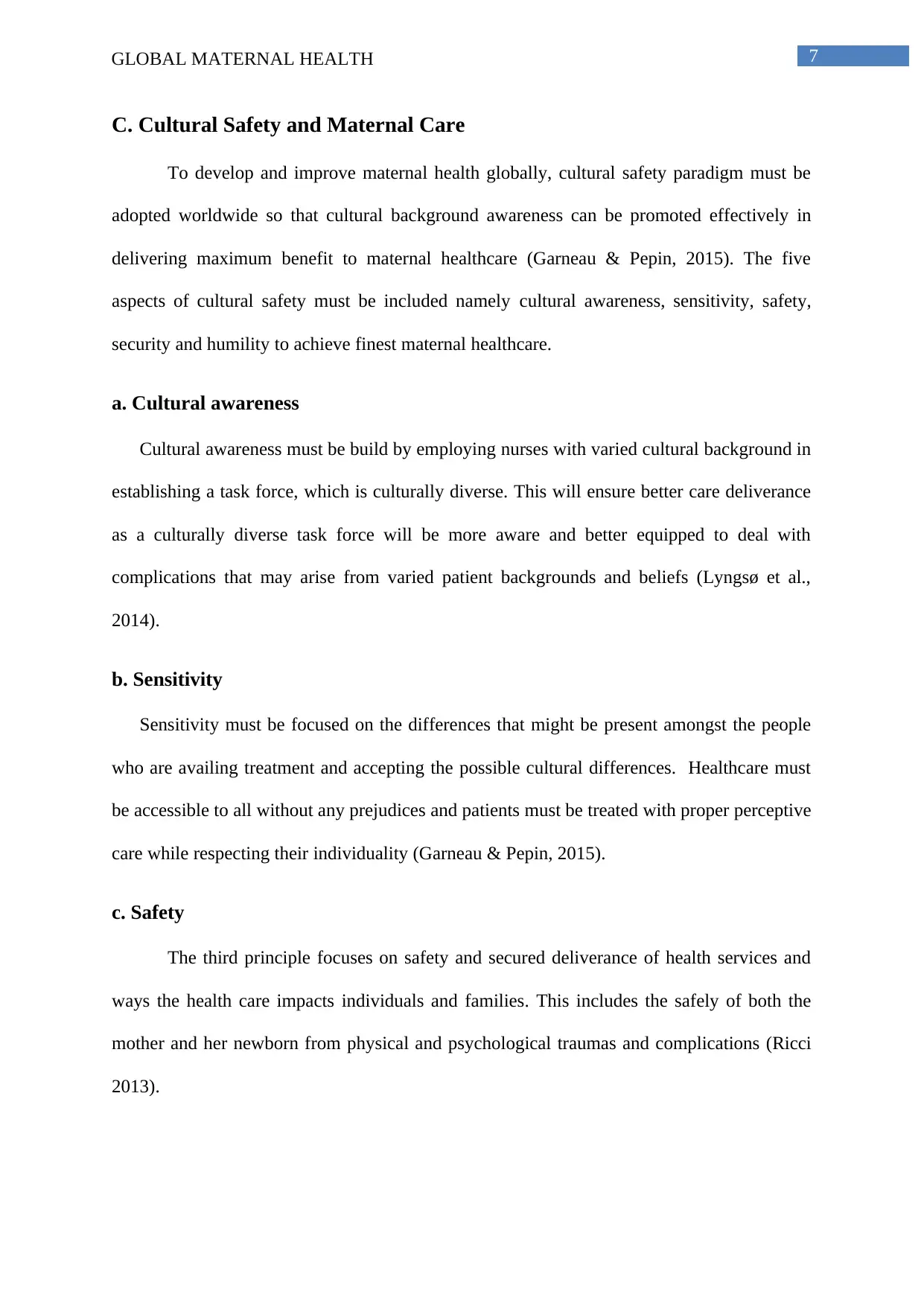
7GLOBAL MATERNAL HEALTH
C. Cultural Safety and Maternal Care
To develop and improve maternal health globally, cultural safety paradigm must be
adopted worldwide so that cultural background awareness can be promoted effectively in
delivering maximum benefit to maternal healthcare (Garneau & Pepin, 2015). The five
aspects of cultural safety must be included namely cultural awareness, sensitivity, safety,
security and humility to achieve finest maternal healthcare.
a. Cultural awareness
Cultural awareness must be build by employing nurses with varied cultural background in
establishing a task force, which is culturally diverse. This will ensure better care deliverance
as a culturally diverse task force will be more aware and better equipped to deal with
complications that may arise from varied patient backgrounds and beliefs (Lyngsø et al.,
2014).
b. Sensitivity
Sensitivity must be focused on the differences that might be present amongst the people
who are availing treatment and accepting the possible cultural differences. Healthcare must
be accessible to all without any prejudices and patients must be treated with proper perceptive
care while respecting their individuality (Garneau & Pepin, 2015).
c. Safety
The third principle focuses on safety and secured deliverance of health services and
ways the health care impacts individuals and families. This includes the safely of both the
mother and her newborn from physical and psychological traumas and complications (Ricci
2013).
C. Cultural Safety and Maternal Care
To develop and improve maternal health globally, cultural safety paradigm must be
adopted worldwide so that cultural background awareness can be promoted effectively in
delivering maximum benefit to maternal healthcare (Garneau & Pepin, 2015). The five
aspects of cultural safety must be included namely cultural awareness, sensitivity, safety,
security and humility to achieve finest maternal healthcare.
a. Cultural awareness
Cultural awareness must be build by employing nurses with varied cultural background in
establishing a task force, which is culturally diverse. This will ensure better care deliverance
as a culturally diverse task force will be more aware and better equipped to deal with
complications that may arise from varied patient backgrounds and beliefs (Lyngsø et al.,
2014).
b. Sensitivity
Sensitivity must be focused on the differences that might be present amongst the people
who are availing treatment and accepting the possible cultural differences. Healthcare must
be accessible to all without any prejudices and patients must be treated with proper perceptive
care while respecting their individuality (Garneau & Pepin, 2015).
c. Safety
The third principle focuses on safety and secured deliverance of health services and
ways the health care impacts individuals and families. This includes the safely of both the
mother and her newborn from physical and psychological traumas and complications (Ricci
2013).
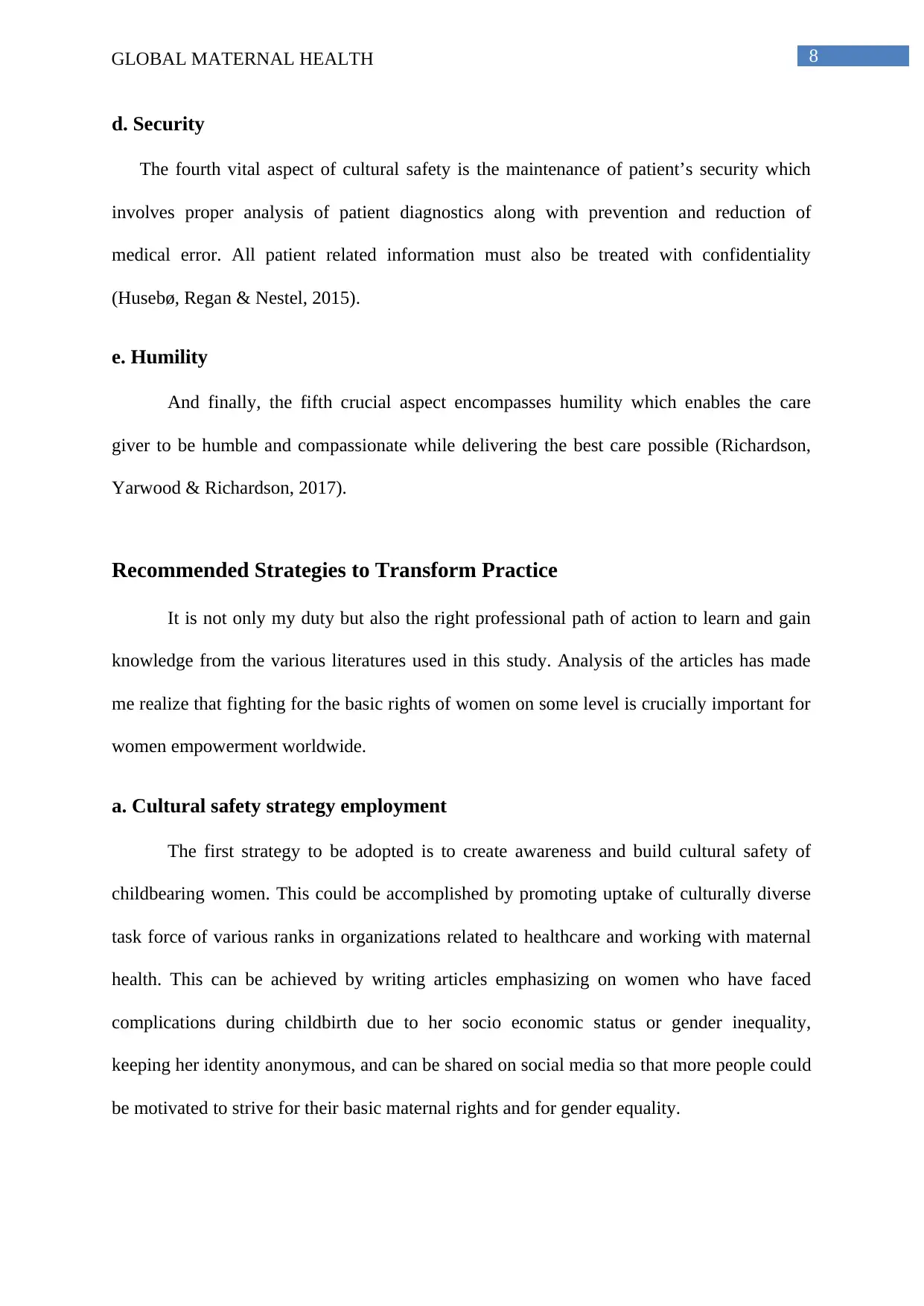
8GLOBAL MATERNAL HEALTH
d. Security
The fourth vital aspect of cultural safety is the maintenance of patient’s security which
involves proper analysis of patient diagnostics along with prevention and reduction of
medical error. All patient related information must also be treated with confidentiality
(Husebø, Regan & Nestel, 2015).
e. Humility
And finally, the fifth crucial aspect encompasses humility which enables the care
giver to be humble and compassionate while delivering the best care possible (Richardson,
Yarwood & Richardson, 2017).
Recommended Strategies to Transform Practice
It is not only my duty but also the right professional path of action to learn and gain
knowledge from the various literatures used in this study. Analysis of the articles has made
me realize that fighting for the basic rights of women on some level is crucially important for
women empowerment worldwide.
a. Cultural safety strategy employment
The first strategy to be adopted is to create awareness and build cultural safety of
childbearing women. This could be accomplished by promoting uptake of culturally diverse
task force of various ranks in organizations related to healthcare and working with maternal
health. This can be achieved by writing articles emphasizing on women who have faced
complications during childbirth due to her socio economic status or gender inequality,
keeping her identity anonymous, and can be shared on social media so that more people could
be motivated to strive for their basic maternal rights and for gender equality.
d. Security
The fourth vital aspect of cultural safety is the maintenance of patient’s security which
involves proper analysis of patient diagnostics along with prevention and reduction of
medical error. All patient related information must also be treated with confidentiality
(Husebø, Regan & Nestel, 2015).
e. Humility
And finally, the fifth crucial aspect encompasses humility which enables the care
giver to be humble and compassionate while delivering the best care possible (Richardson,
Yarwood & Richardson, 2017).
Recommended Strategies to Transform Practice
It is not only my duty but also the right professional path of action to learn and gain
knowledge from the various literatures used in this study. Analysis of the articles has made
me realize that fighting for the basic rights of women on some level is crucially important for
women empowerment worldwide.
a. Cultural safety strategy employment
The first strategy to be adopted is to create awareness and build cultural safety of
childbearing women. This could be accomplished by promoting uptake of culturally diverse
task force of various ranks in organizations related to healthcare and working with maternal
health. This can be achieved by writing articles emphasizing on women who have faced
complications during childbirth due to her socio economic status or gender inequality,
keeping her identity anonymous, and can be shared on social media so that more people could
be motivated to strive for their basic maternal rights and for gender equality.
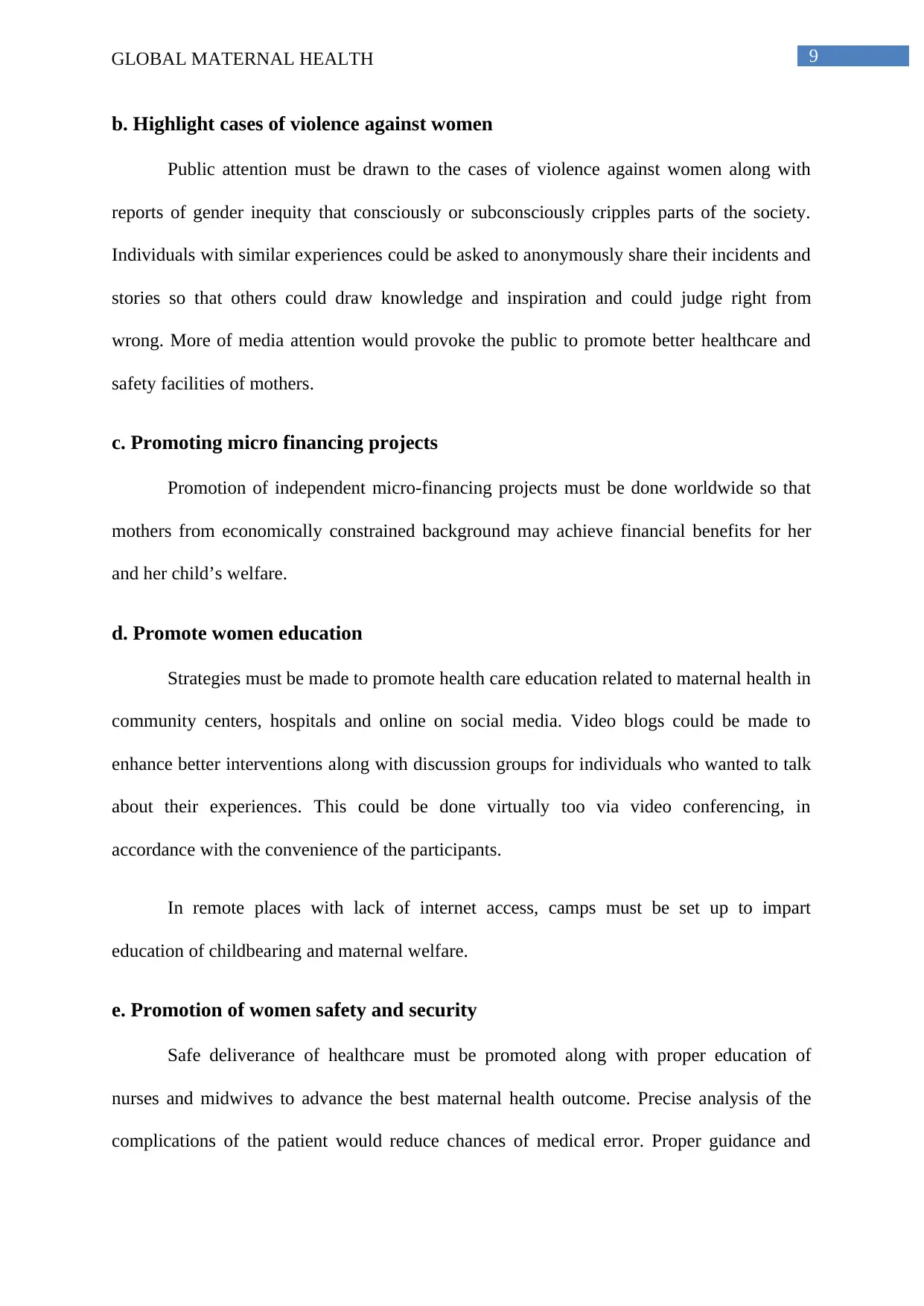
9GLOBAL MATERNAL HEALTH
b. Highlight cases of violence against women
Public attention must be drawn to the cases of violence against women along with
reports of gender inequity that consciously or subconsciously cripples parts of the society.
Individuals with similar experiences could be asked to anonymously share their incidents and
stories so that others could draw knowledge and inspiration and could judge right from
wrong. More of media attention would provoke the public to promote better healthcare and
safety facilities of mothers.
c. Promoting micro financing projects
Promotion of independent micro-financing projects must be done worldwide so that
mothers from economically constrained background may achieve financial benefits for her
and her child’s welfare.
d. Promote women education
Strategies must be made to promote health care education related to maternal health in
community centers, hospitals and online on social media. Video blogs could be made to
enhance better interventions along with discussion groups for individuals who wanted to talk
about their experiences. This could be done virtually too via video conferencing, in
accordance with the convenience of the participants.
In remote places with lack of internet access, camps must be set up to impart
education of childbearing and maternal welfare.
e. Promotion of women safety and security
Safe deliverance of healthcare must be promoted along with proper education of
nurses and midwives to advance the best maternal health outcome. Precise analysis of the
complications of the patient would reduce chances of medical error. Proper guidance and
b. Highlight cases of violence against women
Public attention must be drawn to the cases of violence against women along with
reports of gender inequity that consciously or subconsciously cripples parts of the society.
Individuals with similar experiences could be asked to anonymously share their incidents and
stories so that others could draw knowledge and inspiration and could judge right from
wrong. More of media attention would provoke the public to promote better healthcare and
safety facilities of mothers.
c. Promoting micro financing projects
Promotion of independent micro-financing projects must be done worldwide so that
mothers from economically constrained background may achieve financial benefits for her
and her child’s welfare.
d. Promote women education
Strategies must be made to promote health care education related to maternal health in
community centers, hospitals and online on social media. Video blogs could be made to
enhance better interventions along with discussion groups for individuals who wanted to talk
about their experiences. This could be done virtually too via video conferencing, in
accordance with the convenience of the participants.
In remote places with lack of internet access, camps must be set up to impart
education of childbearing and maternal welfare.
e. Promotion of women safety and security
Safe deliverance of healthcare must be promoted along with proper education of
nurses and midwives to advance the best maternal health outcome. Precise analysis of the
complications of the patient would reduce chances of medical error. Proper guidance and
Secure Best Marks with AI Grader
Need help grading? Try our AI Grader for instant feedback on your assignments.
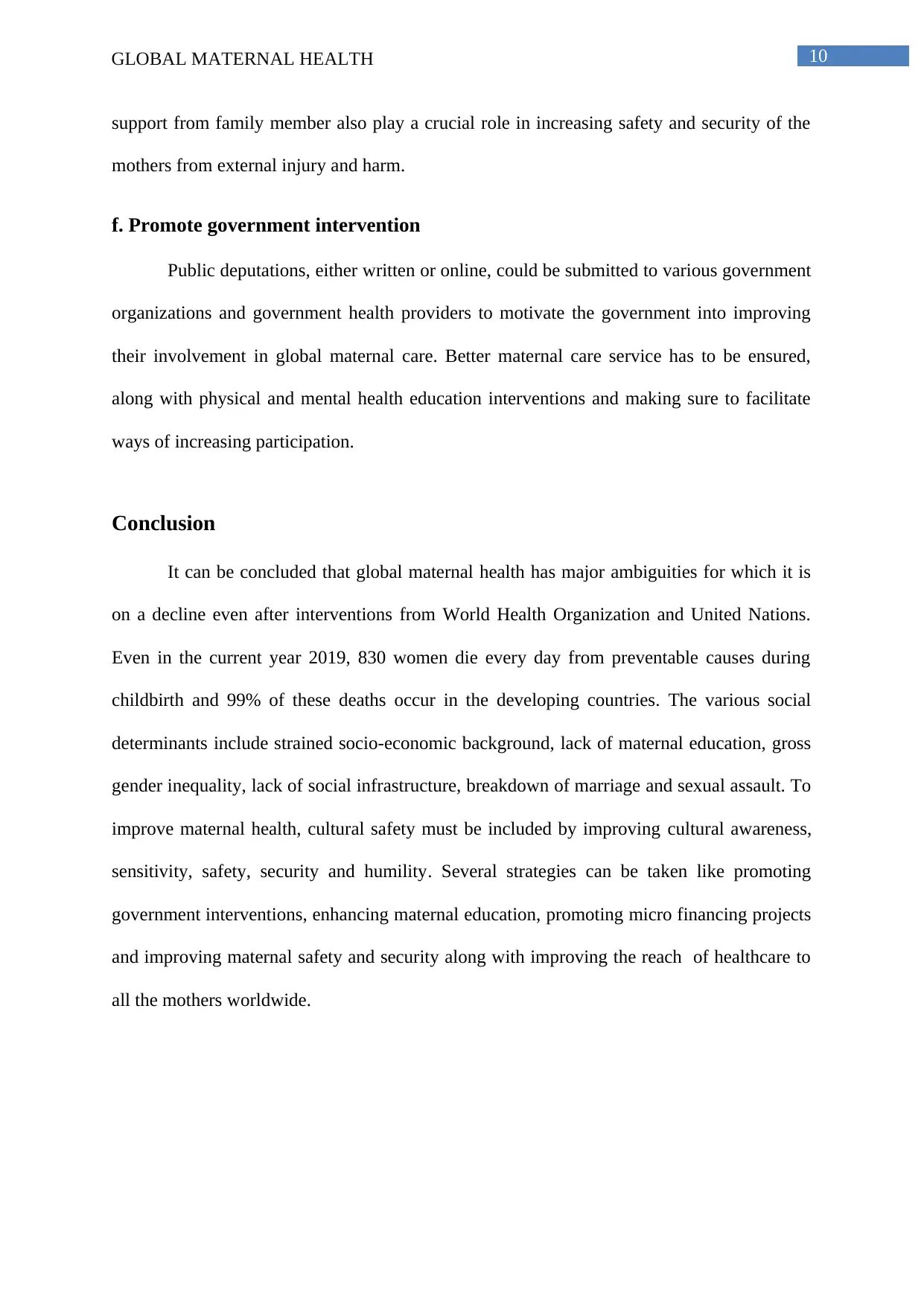
10GLOBAL MATERNAL HEALTH
support from family member also play a crucial role in increasing safety and security of the
mothers from external injury and harm.
f. Promote government intervention
Public deputations, either written or online, could be submitted to various government
organizations and government health providers to motivate the government into improving
their involvement in global maternal care. Better maternal care service has to be ensured,
along with physical and mental health education interventions and making sure to facilitate
ways of increasing participation.
Conclusion
It can be concluded that global maternal health has major ambiguities for which it is
on a decline even after interventions from World Health Organization and United Nations.
Even in the current year 2019, 830 women die every day from preventable causes during
childbirth and 99% of these deaths occur in the developing countries. The various social
determinants include strained socio-economic background, lack of maternal education, gross
gender inequality, lack of social infrastructure, breakdown of marriage and sexual assault. To
improve maternal health, cultural safety must be included by improving cultural awareness,
sensitivity, safety, security and humility. Several strategies can be taken like promoting
government interventions, enhancing maternal education, promoting micro financing projects
and improving maternal safety and security along with improving the reach of healthcare to
all the mothers worldwide.
support from family member also play a crucial role in increasing safety and security of the
mothers from external injury and harm.
f. Promote government intervention
Public deputations, either written or online, could be submitted to various government
organizations and government health providers to motivate the government into improving
their involvement in global maternal care. Better maternal care service has to be ensured,
along with physical and mental health education interventions and making sure to facilitate
ways of increasing participation.
Conclusion
It can be concluded that global maternal health has major ambiguities for which it is
on a decline even after interventions from World Health Organization and United Nations.
Even in the current year 2019, 830 women die every day from preventable causes during
childbirth and 99% of these deaths occur in the developing countries. The various social
determinants include strained socio-economic background, lack of maternal education, gross
gender inequality, lack of social infrastructure, breakdown of marriage and sexual assault. To
improve maternal health, cultural safety must be included by improving cultural awareness,
sensitivity, safety, security and humility. Several strategies can be taken like promoting
government interventions, enhancing maternal education, promoting micro financing projects
and improving maternal safety and security along with improving the reach of healthcare to
all the mothers worldwide.
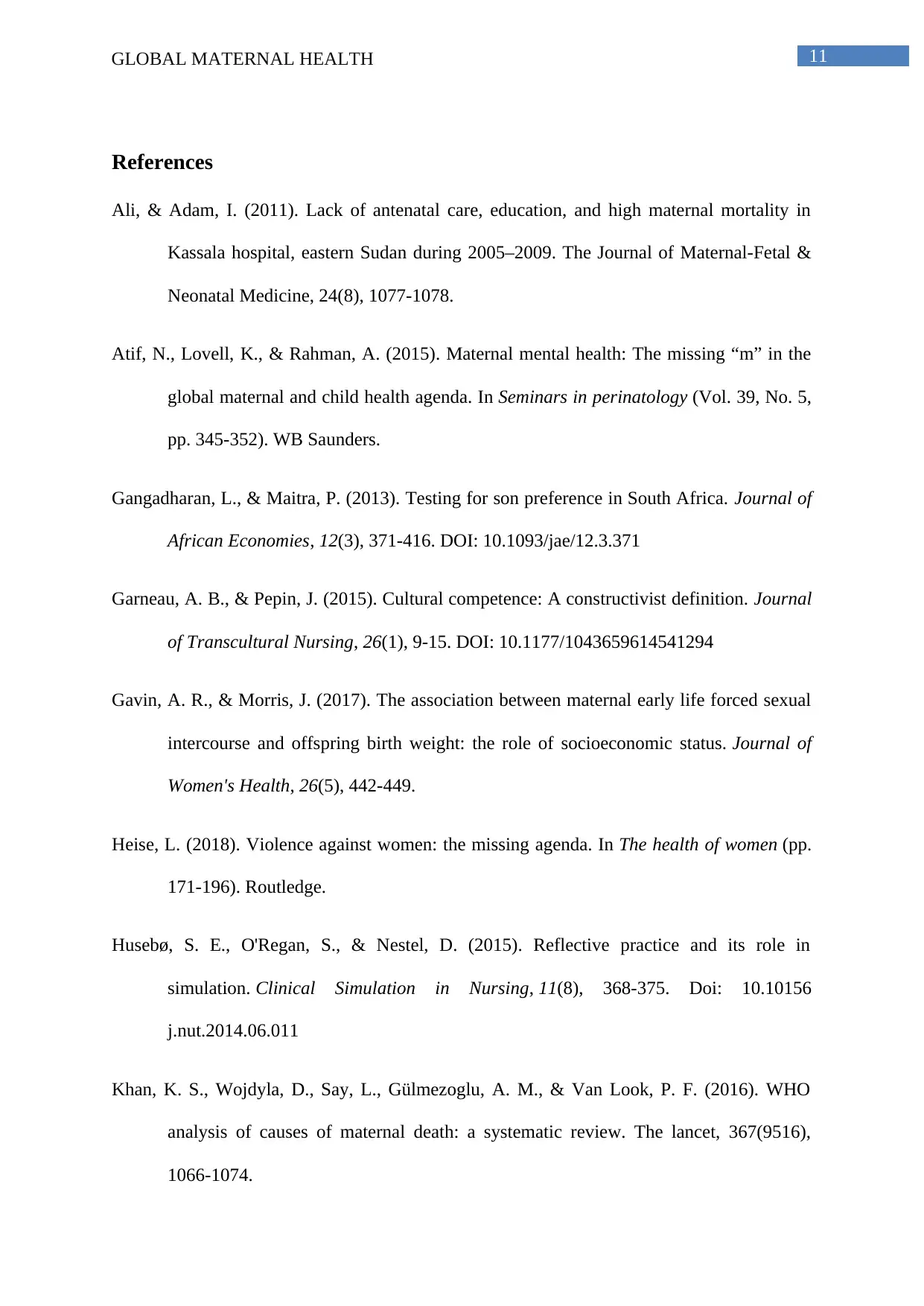
11GLOBAL MATERNAL HEALTH
References
Ali, & Adam, I. (2011). Lack of antenatal care, education, and high maternal mortality in
Kassala hospital, eastern Sudan during 2005–2009. The Journal of Maternal-Fetal &
Neonatal Medicine, 24(8), 1077-1078.
Atif, N., Lovell, K., & Rahman, A. (2015). Maternal mental health: The missing “m” in the
global maternal and child health agenda. In Seminars in perinatology (Vol. 39, No. 5,
pp. 345-352). WB Saunders.
Gangadharan, L., & Maitra, P. (2013). Testing for son preference in South Africa. Journal of
African Economies, 12(3), 371-416. DOI: 10.1093/jae/12.3.371
Garneau, A. B., & Pepin, J. (2015). Cultural competence: A constructivist definition. Journal
of Transcultural Nursing, 26(1), 9-15. DOI: 10.1177/1043659614541294
Gavin, A. R., & Morris, J. (2017). The association between maternal early life forced sexual
intercourse and offspring birth weight: the role of socioeconomic status. Journal of
Women's Health, 26(5), 442-449.
Heise, L. (2018). Violence against women: the missing agenda. In The health of women (pp.
171-196). Routledge.
Husebø, S. E., O'Regan, S., & Nestel, D. (2015). Reflective practice and its role in
simulation. Clinical Simulation in Nursing, 11(8), 368-375. Doi: 10.10156
j.nut.2014.06.011
Khan, K. S., Wojdyla, D., Say, L., Gülmezoglu, A. M., & Van Look, P. F. (2016). WHO
analysis of causes of maternal death: a systematic review. The lancet, 367(9516),
1066-1074.
References
Ali, & Adam, I. (2011). Lack of antenatal care, education, and high maternal mortality in
Kassala hospital, eastern Sudan during 2005–2009. The Journal of Maternal-Fetal &
Neonatal Medicine, 24(8), 1077-1078.
Atif, N., Lovell, K., & Rahman, A. (2015). Maternal mental health: The missing “m” in the
global maternal and child health agenda. In Seminars in perinatology (Vol. 39, No. 5,
pp. 345-352). WB Saunders.
Gangadharan, L., & Maitra, P. (2013). Testing for son preference in South Africa. Journal of
African Economies, 12(3), 371-416. DOI: 10.1093/jae/12.3.371
Garneau, A. B., & Pepin, J. (2015). Cultural competence: A constructivist definition. Journal
of Transcultural Nursing, 26(1), 9-15. DOI: 10.1177/1043659614541294
Gavin, A. R., & Morris, J. (2017). The association between maternal early life forced sexual
intercourse and offspring birth weight: the role of socioeconomic status. Journal of
Women's Health, 26(5), 442-449.
Heise, L. (2018). Violence against women: the missing agenda. In The health of women (pp.
171-196). Routledge.
Husebø, S. E., O'Regan, S., & Nestel, D. (2015). Reflective practice and its role in
simulation. Clinical Simulation in Nursing, 11(8), 368-375. Doi: 10.10156
j.nut.2014.06.011
Khan, K. S., Wojdyla, D., Say, L., Gülmezoglu, A. M., & Van Look, P. F. (2016). WHO
analysis of causes of maternal death: a systematic review. The lancet, 367(9516),
1066-1074.
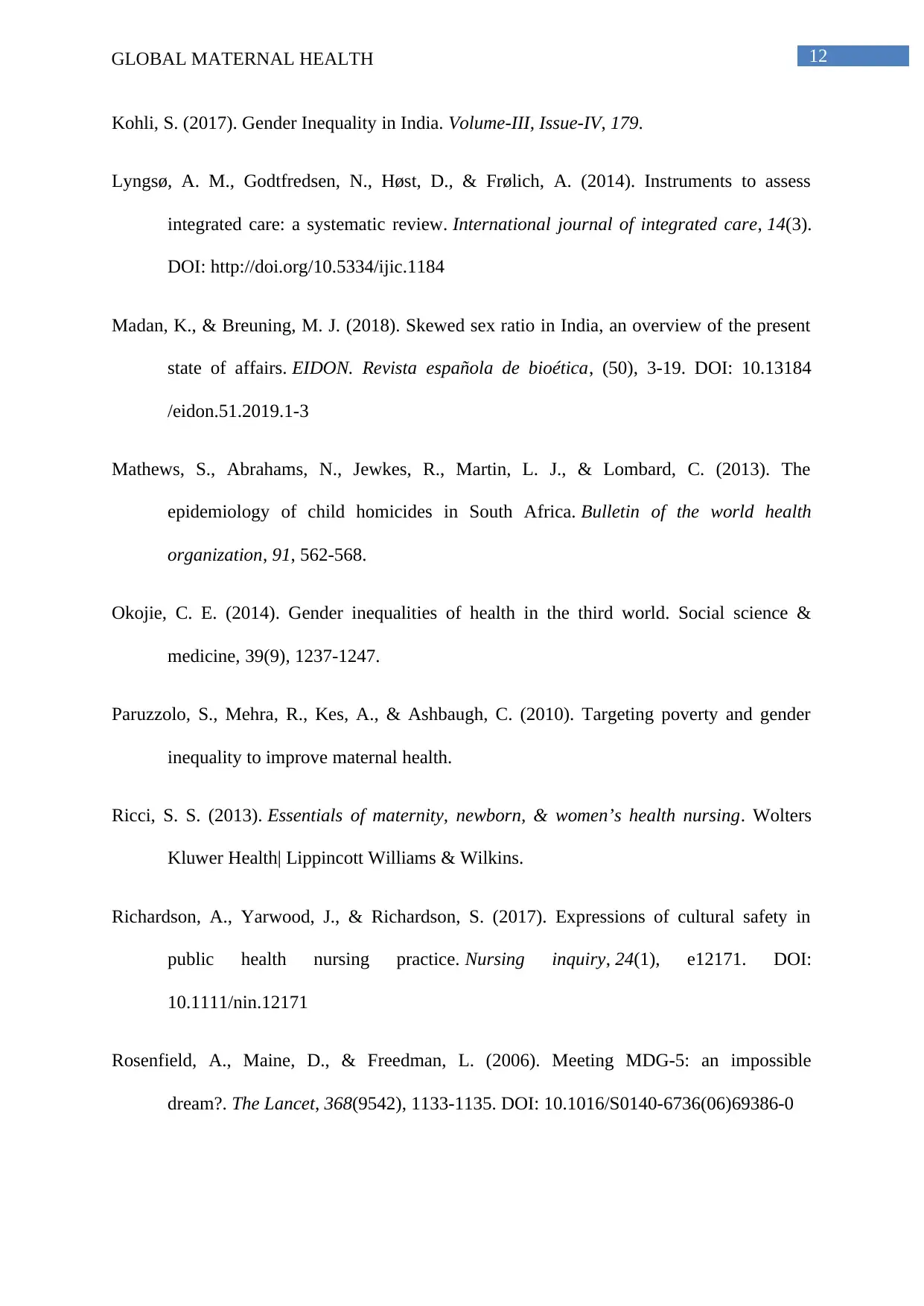
12GLOBAL MATERNAL HEALTH
Kohli, S. (2017). Gender Inequality in India. Volume-III, Issue-IV, 179.
Lyngsø, A. M., Godtfredsen, N., Høst, D., & Frølich, A. (2014). Instruments to assess
integrated care: a systematic review. International journal of integrated care, 14(3).
DOI: http://doi.org/10.5334/ijic.1184
Madan, K., & Breuning, M. J. (2018). Skewed sex ratio in India, an overview of the present
state of affairs. EIDON. Revista española de bioética, (50), 3-19. DOI: 10.13184
/eidon.51.2019.1-3
Mathews, S., Abrahams, N., Jewkes, R., Martin, L. J., & Lombard, C. (2013). The
epidemiology of child homicides in South Africa. Bulletin of the world health
organization, 91, 562-568.
Okojie, C. E. (2014). Gender inequalities of health in the third world. Social science &
medicine, 39(9), 1237-1247.
Paruzzolo, S., Mehra, R., Kes, A., & Ashbaugh, C. (2010). Targeting poverty and gender
inequality to improve maternal health.
Ricci, S. S. (2013). Essentials of maternity, newborn, & women’s health nursing. Wolters
Kluwer Health| Lippincott Williams & Wilkins.
Richardson, A., Yarwood, J., & Richardson, S. (2017). Expressions of cultural safety in
public health nursing practice. Nursing inquiry, 24(1), e12171. DOI:
10.1111/nin.12171
Rosenfield, A., Maine, D., & Freedman, L. (2006). Meeting MDG-5: an impossible
dream?. The Lancet, 368(9542), 1133-1135. DOI: 10.1016/S0140-6736(06)69386-0
Kohli, S. (2017). Gender Inequality in India. Volume-III, Issue-IV, 179.
Lyngsø, A. M., Godtfredsen, N., Høst, D., & Frølich, A. (2014). Instruments to assess
integrated care: a systematic review. International journal of integrated care, 14(3).
DOI: http://doi.org/10.5334/ijic.1184
Madan, K., & Breuning, M. J. (2018). Skewed sex ratio in India, an overview of the present
state of affairs. EIDON. Revista española de bioética, (50), 3-19. DOI: 10.13184
/eidon.51.2019.1-3
Mathews, S., Abrahams, N., Jewkes, R., Martin, L. J., & Lombard, C. (2013). The
epidemiology of child homicides in South Africa. Bulletin of the world health
organization, 91, 562-568.
Okojie, C. E. (2014). Gender inequalities of health in the third world. Social science &
medicine, 39(9), 1237-1247.
Paruzzolo, S., Mehra, R., Kes, A., & Ashbaugh, C. (2010). Targeting poverty and gender
inequality to improve maternal health.
Ricci, S. S. (2013). Essentials of maternity, newborn, & women’s health nursing. Wolters
Kluwer Health| Lippincott Williams & Wilkins.
Richardson, A., Yarwood, J., & Richardson, S. (2017). Expressions of cultural safety in
public health nursing practice. Nursing inquiry, 24(1), e12171. DOI:
10.1111/nin.12171
Rosenfield, A., Maine, D., & Freedman, L. (2006). Meeting MDG-5: an impossible
dream?. The Lancet, 368(9542), 1133-1135. DOI: 10.1016/S0140-6736(06)69386-0
Paraphrase This Document
Need a fresh take? Get an instant paraphrase of this document with our AI Paraphraser
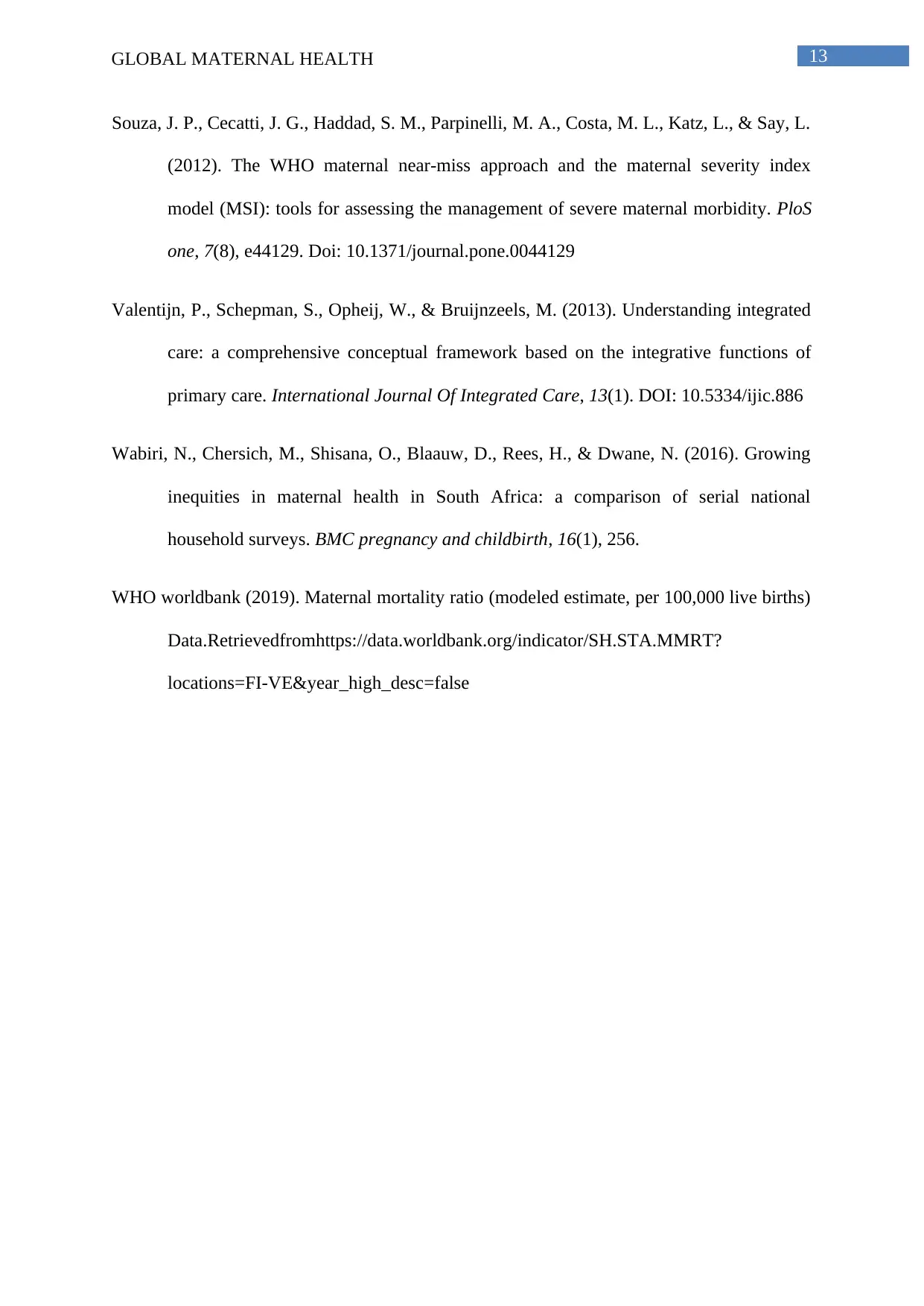
13GLOBAL MATERNAL HEALTH
Souza, J. P., Cecatti, J. G., Haddad, S. M., Parpinelli, M. A., Costa, M. L., Katz, L., & Say, L.
(2012). The WHO maternal near-miss approach and the maternal severity index
model (MSI): tools for assessing the management of severe maternal morbidity. PloS
one, 7(8), e44129. Doi: 10.1371/journal.pone.0044129
Valentijn, P., Schepman, S., Opheij, W., & Bruijnzeels, M. (2013). Understanding integrated
care: a comprehensive conceptual framework based on the integrative functions of
primary care. International Journal Of Integrated Care, 13(1). DOI: 10.5334/ijic.886
Wabiri, N., Chersich, M., Shisana, O., Blaauw, D., Rees, H., & Dwane, N. (2016). Growing
inequities in maternal health in South Africa: a comparison of serial national
household surveys. BMC pregnancy and childbirth, 16(1), 256.
WHO worldbank (2019). Maternal mortality ratio (modeled estimate, per 100,000 live births)
Data.Retrievedfromhttps://data.worldbank.org/indicator/SH.STA.MMRT?
locations=FI-VE&year_high_desc=false
Souza, J. P., Cecatti, J. G., Haddad, S. M., Parpinelli, M. A., Costa, M. L., Katz, L., & Say, L.
(2012). The WHO maternal near-miss approach and the maternal severity index
model (MSI): tools for assessing the management of severe maternal morbidity. PloS
one, 7(8), e44129. Doi: 10.1371/journal.pone.0044129
Valentijn, P., Schepman, S., Opheij, W., & Bruijnzeels, M. (2013). Understanding integrated
care: a comprehensive conceptual framework based on the integrative functions of
primary care. International Journal Of Integrated Care, 13(1). DOI: 10.5334/ijic.886
Wabiri, N., Chersich, M., Shisana, O., Blaauw, D., Rees, H., & Dwane, N. (2016). Growing
inequities in maternal health in South Africa: a comparison of serial national
household surveys. BMC pregnancy and childbirth, 16(1), 256.
WHO worldbank (2019). Maternal mortality ratio (modeled estimate, per 100,000 live births)
Data.Retrievedfromhttps://data.worldbank.org/indicator/SH.STA.MMRT?
locations=FI-VE&year_high_desc=false
1 out of 14
Related Documents
Your All-in-One AI-Powered Toolkit for Academic Success.
+13062052269
info@desklib.com
Available 24*7 on WhatsApp / Email
![[object Object]](/_next/static/media/star-bottom.7253800d.svg)
Unlock your academic potential
© 2024 | Zucol Services PVT LTD | All rights reserved.





